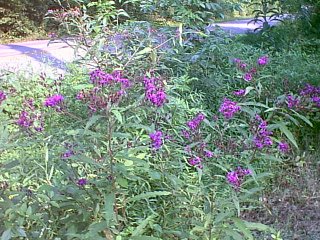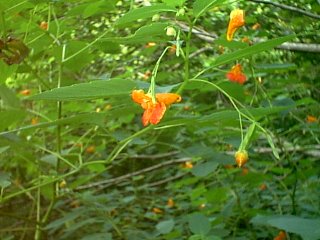
Every year I think of all the things I want to do when spring comes, hundreds of
projects I can never accomplish. This year I failed miserably, and therefore
lucked out. If I had started the orchard on the Menlo lot, added another garden
bed and three or four more planters here, my efforts would have been wasted
because of the searing heat and drought this past summer.
I carried bucket after bucket of water to the straggly bachelor buttons I had
started from seed and was rewarded with only a bloom now and then, seldom
more than two flowers at the same time. I would have liked a dense bed of
them, for the flowers were blue and there don't seem to be many truly blue
flowers, most are tinged with enough red to make them more lavender than
blue.
But all through the heat and drought the wildflowers bloomed and bloomed
with no one tending them. Their leaves sometimes wilted a bit when the sun
had blazed down all day, but would recover by the next morning.
Consider the lilies of the field....
No lilies, no fields, but thickets of wild touch-me-not grew on the banks of the
dry creek bed, more than any previous year. Their orange flowers shaped like
little cornucopias drew hummingbirds, delightful to observe. Once I watched
from the bank as two of the tiny birds fought over one patch of blossoms.
One hung in the air against his blur of wings, a tiny guard claiming those blooms
as his own, darting forth to attack the other who hovered near and would not
give up.

The common name of this plant is jewel weed, probably because of the
translucent yellow-green and pinkish stems. The juice from the stalk is
considered an antidote for poison oak. It is called wild touch-me-not
because its sickle-shaped seeds burst open at a touch when dry.
Orange is another minority color among the flowers.
There were also lots of wild sunflowers, the flowers much smaller than the
cultivated kind, but tall and cheerful massed along the creek bank, making
my walks along the dry bed most pleasant. Down near the bridge tall stalks
of bright purple ironweed accented the yellow sunflowers.
Joe pye weed with clusters of small pink or white flowers grew along the
pasture fence and on the ditch bank by the road, the little florets at first
distinct, then becoming ragged as the summer wore on, so that from the
distance they appeared to be a fuzzy mass.

It was a delight to come upon an occasional cardinal flower with its
notched crimson petals, usually only one and usually low on the bank,
but occasionally two, side by side. The same with the lobelias, their
hooded blossoms providing another example of really blue flowers.
My mother used to laugh when she saw a flower described in the Field
Guide to Wildflowers as "escaped". She said she had visions of flowers
running down the road with gardeners in hot pursuit.
The Term "escaped" meant the identified wildflowers had also been
cultivated.I wanted to reverse the process and wished I had saved seeds
from the cardinals and lobelias. I had bought a small pot of lobelias, the
kind with prostrate stems that hung over the sides of the pot. It bloomed
continuously all summer, lovely little blue flowers with the distinctive hoods.
The plastic tag identified it as an annual; the tall wild lobelias survive the
winters and bloom again.
But this past summer it was too hot even after the sun went down to do
much work outside, it was all I could do to keep the grass cut. I couldn't
bear to think of building planters or making more flower beds, and the
"escaped" flowers would have to be confined so that I could mow around
them.
A few years ago, there were only a few stalks of jewel weed here and there.
Now there are thickets, and there are small clumps of them all up and down
the creek.I can hope that the cardinals and lobelias will likewise spread.
And next spring I would... But that is the cry of all gardeners who dream
over seed catalogues throughout the fall and winter. Next spring, next year.....
No comments:
Post a Comment